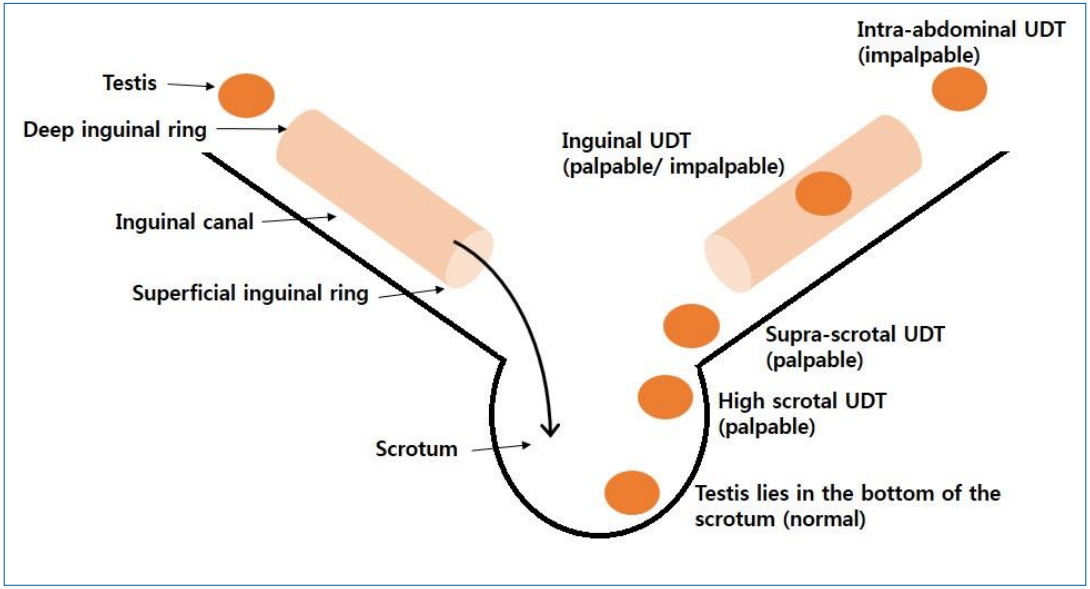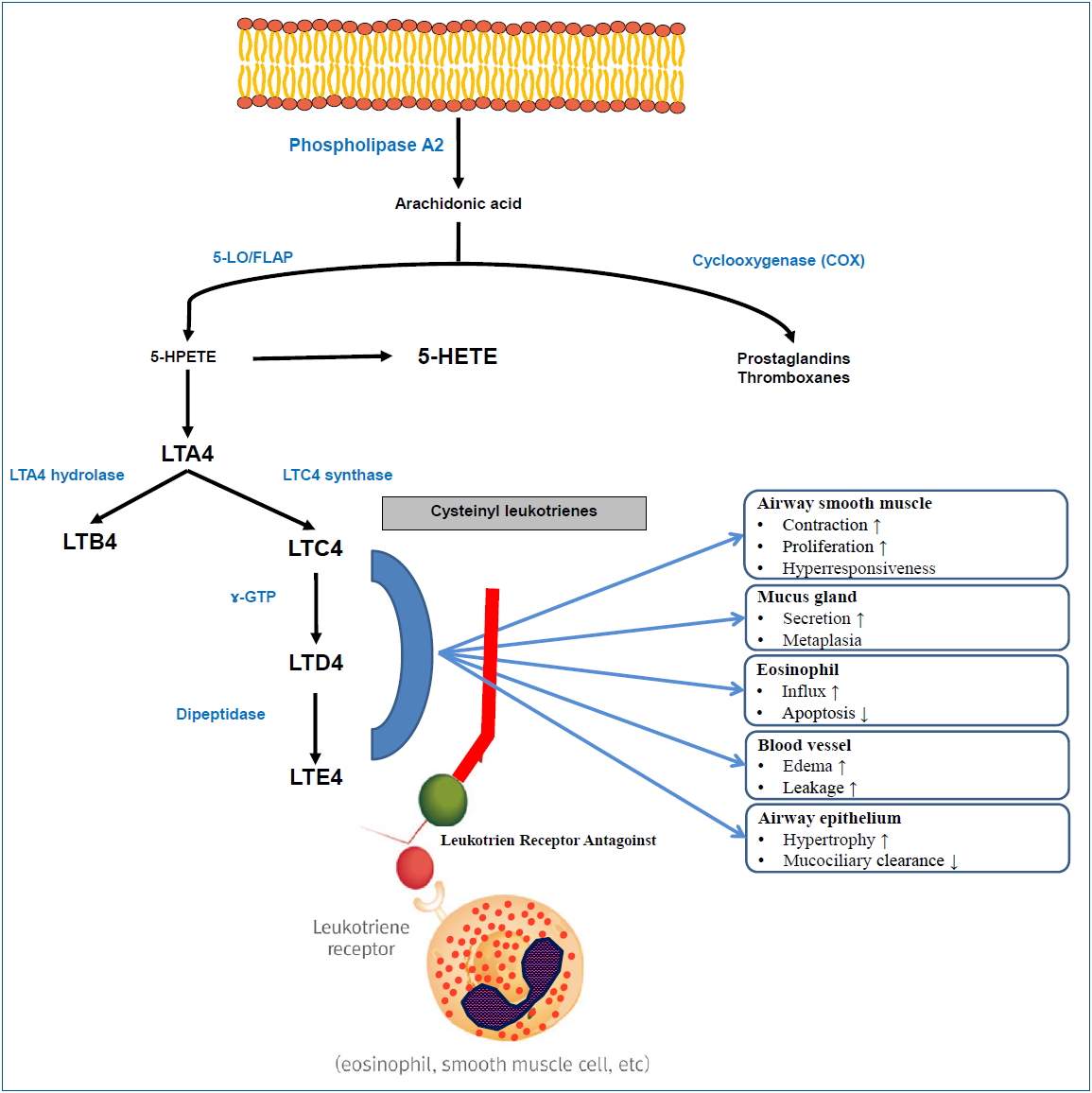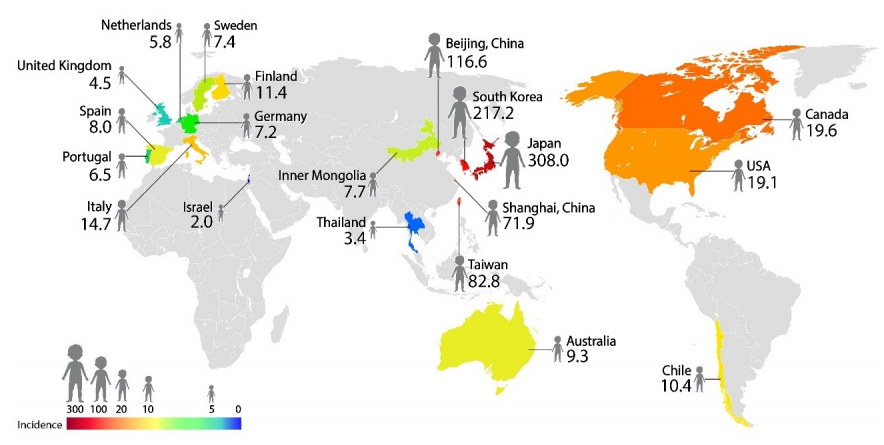Review article
- Page Path
-
- HOME
- ARTICLE CATEGORY
- Review article
- Review Article
- Other
- Comparison of diagnostic and treatment guidelines for undescended testis
- Jaeho Shin, Ga Won Jeon
- Clin Exp Pediatr. 2020;63(11):415-421. Published online March 23, 2020
-

Primary caregivers should consider surgical specialist referral of patients with undescended testis if no descent occurs by 6 months, undescended testis is newly diagnosed after 6 months of age, or testicular torsion is suspected. Orchiopexy is recommended between 6 and 18 months at the latest. The original location of the testes and the age at orchiopexy are predictive factors for infertility and malignancy later in life.
- Endocrinology
- Air pollution and childhood obesity
- Moon Young Seo, Shin-Hye Kim, Mi Jung Park
- Clin Exp Pediatr. 2020;63(10):382-388. Published online March 27, 2020
-

Questions: What are the possible effects of air pollution on the occurrence of childhood obesity and what are the mechanisms?
Finding: Epidemiologic studies suggest that air pollutants might act as obesogens in the pediatric population, and their possible mechanisms include oxidative stress, physical inactivity, and epigenetic modulation.
Meaning: This paper reviews updated information on air pollution, one of the modifiable environmental factors in childhood obesity.
- Allergy
- Montelukast use over the past 20 years: monitoring of its effects and safety issues
- Yong Ju Lee, Chang-Keun Kim
- Clin Exp Pediatr. 2020;63(10):376-381. Published online February 5, 2020
-

Although the efficacy of montelukast is inferior to that of ICS, both physicians and parents prefer montelukast to ICSs.
EDN may be a useful biomarker for the treatment and monitoring of preschool children with asthma.
The US FDA requires boxed warning about serious neuropsychiatric events of montelukast, therefore, physicians should consider the benefits and risks of montelukast before prescribing it.
- Pulmonology
- Overview of management of children with COVID-19
- Dyah Kanya Wati, Arya Krisna Manggala
- Clin Exp Pediatr. 2020;63(9):345-354. Published online July 17, 2020
-

The specific treatments for COVID-19 in children remain inconclusive and debatable despite effectively decreasing its signs and symptoms.
The need for clinical trials and reports should be investigated.
- Gastroenterology
- Increasing incidence of inflammatory bowel disease in children and adolescents: significance of environmental factors
- Sowon Park, Yunkoo Kang, Hong Koh, Seung Kim
- Clin Exp Pediatr. 2020;63(9):337-344. Published online December 6, 2019
-

Inflammatory bowel disease (IBD) is a chronic relapsing immune-mediated disease of the intestinal tract. Although its prevalence is reportedly lower in Asia than in Western countries, the rapid increase in the incidence of IBD has drawn attention to its etiology, including genetic susceptibility and environmental factors. Specifically, recent studies concerning dietary treatments and intestinal microbiota suggest that these factors may...
- Nutrition
- Components of human breast milk: from macronutrient to microbiome and microRNA
- Su Yeong Kim, Dae Yong Yi
- Clin Exp Pediatr. 2020;63(8):301-309. Published online March 23, 2020
-

Human breast milk (HBM) is essential for the infant’s growth and development right after birth and is an irreplaceable source of nutrition for early human survival. Various infant formulas have many similarities to HBM in many components, but there is no perfect substitute for HBM. Recently, various breast milk components and their roles have been studied according to the development...
- Neurology
- Autoimmune encephalitis and epilepsy: evolving definition and clinical spectrum
- Joo Hee Seo, Yun-Jin Lee, Ki Hyeong Lee, Elakkat Gireesh, Holly Skinner, Michael Westerveld
- Clin Exp Pediatr. 2020;63(8):291-300. Published online August 16, 2019
-

Advances in autoimmune encephalitis studies in the past 10 years have led to the identification of new syndromes and biomarkers that have transformed the diagnostic approach to the disorder. The disorder or syndrome has been linked to a wide variety of pathologic processes associated with the neuron-specific autoantibodies targeting intracellular and plasma membrane antigens. However, current criteria for autoimmune encephalitis...
- Neonatology (Perinatology)
- Short- and long-term outcomes of very low birth weight infants in Korea: Korean Neonatal Network update in 2019
- Jang Hoon Lee, YoungAh Youn, Yun Sil Chang; Korean Neonatal Network
- Clin Exp Pediatr. 2020;63(8):284-290. Published online February 5, 2020
-

The Korean Neonatal Network (KNN) has collected population-based data for very low birth weight infants (VLBWIs) born in Korea since 2013. The survival rate of all VLBWIs was 86% in Korea. The overall prevalence of cerebral palsy was 6.2%–6.6%. Bilateral blindness and hearing loss were reported in 0.2%–0.3%, 0.8%–1.9%, respectively. The KNN has published annual reports and papers for facilitating the improvement of VLBWIs outcome in Korea.
- Pulmonology
- The past, present, and future of humidifier disinfectant-associated interstitial lung diseases in children
- Eun Lee, So-Yeon Lee, Soo-Jong Hong
- Clin Exp Pediatr. 2020;63(7):251-258. Published online December 9, 2019
-

Exposure to environmental factors can cause interstitial lung diseases (ILDs); however, such types of ILDs are rare. From 2007 to 2011, an ILD epidemic occurred in South Korea owing to inhalational exposure to toxic chemicals in humidifier disinfectants (HDs). HD-associated ILDs (HD-ILDs) are characterized by rapidly progressing respiratory failure with pulmonary fibrosis and a high mortality rate of 43.8%−58.0%. Although...
- Immunology
- Immunopathogenesis of COVID-19 and early immunomodulators
- Kyung-Yil Lee, Jung-Woo Rhim, Jin-Han Kang
- Clin Exp Pediatr. 2020;63(7):239-250. Published online June 18, 2020
-

The novel coronavirus disease 2019 (COVID-19) is spreading globally. Although its etiologic agent is discovered as severe acute respiratory syndrome coronavirus-2 (SARS-CoV-2), there are many unsolved issues in COVID-19 and other infectious diseases. The causes of different clinical phenotypes and incubation periods among individuals, species specificity, and cytokine storm with lymphopenia as well as the mechanism of damage to organ...
- Allergy
- Drug Allergy in Children: What Should We Know?
- Ji Soo Park, Dong In Suh
- Clin Exp Pediatr. 2020;63(6):203-210. Published online November 12, 2019
-

The drug allergy “label” may have a lifetime of consequences for a child. Many children with alleged drug allergies are proven to be tolerant to the culprit medication when challenged. The field of drug hypersensitivity is a recently evolving field of research, but studies on its epidemiology and diagnostic tools are lacking in children. Clinical history is significant in the...
- Neurology
- Genetic tests by next-generation sequencing in children with developmental delay and/or intellectual disability
- Ji Yoon Han, In Goo Lee
- Clin Exp Pediatr. 2020;63(6):195-202. Published online November 4, 2019
-

Developments in next-generation sequencing (NGS) techogies have assisted in clarifying the diagnosis and treatment of developmental delay/intellectual disability (DD/ID) via molecular genetic testing. Advances in DNA sequencing technology have not only allowed the evolution of targeted panels but also, and more currently enabled genome-wide analyses to progress from research era to clinical practice. Broad acceptance of accuracy- guided targeted gene...
- Factors associated with seizure and cognitive outcomes after epilepsy surgery for low-grade epilepsy-associated neuroepithelial tumors in children
- Ara Ko, Joon Soo Lee
- Clin Exp Pediatr. 2020;63(5):171-177. Published online November 13, 2019
-

Low-grade epilepsy-associated neuroepithelial tumors (LEATs) are responsible for drug-resistant chronic focal epilepsy, and are the second-most common reason for epilepsy surgery in children. LEATs are extremely responsive to surgical treatment, and therefore epilepsy surgery should be considered as a treatment option for LEATs. However, the optimal time for surgery remains controversial, and surgeries are often delayed. In this review, we...
- How can neurological outcomes be predicted in comatose pediatric patients after out-of-hospital cardiac arrest?
- Hyo Jeong Kim
- Clin Exp Pediatr. 2020;63(5):164-170. Published online October 10, 2019
-

The prognosis of patients who are comatose after resuscitation remains uncertain. The accurate prediction of neurological outcome is important for management decisions and counseling. A neurological examination is an important factor for prognostication, but widely used sedatives alter the neurological examination and delay the response recovery. Additional studies including electroencephalography, somatosensory-evoked potentials, brain imaging, and blood biomarkers are useful for...
- Nephrology (Genitourinary)
- Treatment of refractory IgA vasculitis with dapsone: a systematic review
- Keum Hwa Lee, Sung Hwi Hong, Jinhae Jun, Youngheun Jo, Woogyeong Jo, Dayeon Choi, Jeongho Joo, Guhyun Jung, Sunghee Ahn, Andreas Kronbichler, Michael Eisenhut, Jae Il Shin
- Clin Exp Pediatr. 2020;63(5):158-163. Published online September 24, 2019
-

IgA vasculitis, formerly known as Henoch-Schönlein purpura, is a systemic IgA-mediated vasculitis of the small vessels commonly seen in children. The natural history of IgA vasculitis is generally self-limiting; however, one-third of patients experience symptom recurrence and a refractory course. This systematic review examined the use of dapsone in refractory IgA vasculitis cases. A literature search of PubMed databases retrieved...
- Infection
- Epidemiology and clinical features of coronavirus disease 2019 in children
- Soo-Han Choi, Han Wool Kim, Ji-Man Kang, Dong Hyun Kim, Eun Young Cho
- Clin Exp Pediatr. 2020;63(4):125-132. Published online April 6, 2020
-

Coronavirus disease-2019 (COVID-19), which started in Wuhan, China, in December 2019 and declared a worldwide pandemic on March 11, 2020, is a novel infectious disease that causes respiratory illness and death. Pediatric COVID-19 accounts for a small percentage of patients and is often milder than that in adults; however, it can progress to severe disease in some cases. Even neonates...
- Epidemiology, virology, and clinical features of severe acute respiratory syndrome -coronavirus-2 (SARS-CoV-2; Coronavirus Disease-19)
- Su Eun Park
- Clin Exp Pediatr. 2020;63(4):119-124. Published online April 2, 2020
-

A cluster of severe pneumonia of unknown etiology in Wuhan City, Hubei province in China emerged in December 2019. A novel coronavirus named severe acute respiratory syndrome coronavirus-2 (SARS-CoV-2) was isolated from lower respiratory tract sample as the causative agent. The current outbreak of infections with SARS-CoV-2 is termed Coronavirus Disease 2019 (COVID-19) by the World Health Organization (WHO). COVID-19...
- Neurology
- Advanced neuroimaging techniques for evaluating pediatric epilepsy
- Yun Jeong Lee
- Clin Exp Pediatr. 2020;63(3):88-95. Published online February 6, 2020
-

Accurate localization of the seizure onset zone is important for better seizure outcomes and preventing deficits following epilepsy surgery. Recent advances in neuroimaging techniques have increased our understanding of the underlying etiology and improved our ability to noninvasively identify the seizure onset zone. Using epilepsy-specific magnetic resonance imaging (MRI) protocols, structural MRI allows better detection of the seizure onset zone,...
- Hematology
- Genetic classification and confirmation of inherited platelet disorders: current status in Korea
- Ye Jee Shim
- Clin Exp Pediatr. 2020;63(3):79-87. Published online February 6, 2020
-

Inherited platelet disorders (IPDs), which manifest as primary hemostasis defects, often underlie abnormal bleeding and a family history of thrombocytopenia, bone marrow failure, hematologic malignancies, undefined mucocutaneous bleeding disorder, or congenital bony defects. Wide heterogeneity in IPD types with regard to the presence or absence of thrombocytopenia, platelet dysfunction, bone marrow failure, and dysmegakaryopoiesis is observed in patients. The individual...
- Pulmonology
- High-flow nasal cannula oxygen therapy in children: a clinical review
- Ji-Won Kwon
- Clin Exp Pediatr. 2020;63(1):3-7. Published online October 28, 2019
-

High-flow nasal cannula (HFNC) is a relatively safe and effective noninvasive ventilation method that was recently accepted as a treatment option for acute respiratory support before endotracheal intubation or invasive ventilation. The action mechanism of HFNC includes a decrease in nasopharyngeal resistance, washout of dead space, reduction in inflow of ambient air, and an increase in airway pressure. In preterm...
- Nephrology (Genitourinary)
- Reconsideration of urine culture for the diagnosis of acute pyelonephritis in children: a new challenging method for diagnosing acute pyelonephritis
- Jun Ho Lee, Seonkyeong Rhie
- Clin Exp Pediatr. 2019;62(12):433-437. Published online October 18, 2019
-

Acute pyelonephritis (APN) should be detected and treated as soon as possible to reduce the risk of the development of acquired renal scarring. However, in the medical field, urine culture results are not available or considered when the prompt discrimination of APN is necessary and empirical treatment is started. Furthermore, urine culture cannot discriminate APN among children with febrile urinary...
- Neonatology (Perinatology)
- Bronchopulmonary dysplasia: how can we improve its outcomes?
- Tae-Jung Sung
- Clin Exp Pediatr. 2019;62(10):367-373. Published online May 17, 2019
-

Bronchopulmonary dysplasia (BPD) is a chronic lung disease of preterm infants with multiple factors affected from prenatal to postnatal periods. Despite significant advances in neonatal care over almost 50 years, BPD rates have not decreased; in fact, they may have even increased. Since more preterm infants, even at periviable gestational age, survive today, different stages of lung development affect the...
- Cardiology
- Understanding the importance of cerebrovascular involvement in Kawasaki disease
- Jung Sook Yeom, Jae Young Cho, Hyang-Ok Woo
- Clin Exp Pediatr. 2019;62(9):334-339. Published online May 16, 2019
-

Kawasaki disease (KD) is a systemic vasculitis in infants and young children. However, its natural history has not been fully elucidated because the first case was reported in the late 1960s and patients who have recovered are just now entering middle age. Nevertheless, much evidence has raised concerns regarding the subclinical vascular changes that occur in post-KD patients. KD research...
- Allergy
- Phenotypes of allergic diseases in children and their application in clinical situations
- Eun Lee, Soo-Jong Hong
- Clin Exp Pediatr. 2019;62(9):325-333. Published online April 23, 2019
-

Allergic diseases, including allergic rhinitis, asthma, and atopic dermatitis, are common heterogeneous diseases that encompass diverse phenotypes and different pathogeneses. Phenotype studies of allergic diseases can facilitate the identification of risk factors and their underlying pathophysiology, resulting in the application of more effective treatment, selection of better treatment responses, and prediction of prognosis for each phenotype. In the early phase...
- Cardiology
- Reality of Kawasaki disease epidemiology
- Gi Beom Kim
- Clin Exp Pediatr. 2019;62(8):292-296. Published online July 9, 2019
-

Epidemiologic studies of Kawasaki disease (KD) have shown a new pattern or change of its occurrence suggestive of its pathophysiology or risk factors from the first patient with KD reported in 1961. The incidence of KD in Northeast Asian countries including Japan, South Korea, China, and Taiwan is 10–30 times higher than that in the United States and Europe. Knowing...
- Gastroenterology
- The role of fecal calprotectin in pediatric disease
- Su Jin Jeong
- Clin Exp Pediatr. 2019;62(8):287-291. Published online March 28, 2019
-

Fecal calprotectin (FC) is a calcium- and zinc-binding protein of the S100 family, mainly expressed by neutrophils and released during inflammation. FC became an increasingly useful tool both for gastroenterologists and for general practitioners for distinguishing inflammatory bowel disease (IBD) from irritable bowel syndrome. Increasing evidences support the use of this biomarker for diagnosis, follow-up and evaluation of response to...
- Recommended immunization schedule for children and adolescents: Committee on Infectious Diseases of the Korean Pediatric Society, 2018
- Eun Hwa Choi, Su Eun Park, Yae-Jean Kim, Dae Sun Jo, Yun-Kyung Kim, Byung-Wook Eun, Taek-Jin Lee, Jina Lee, Hyunju Lee, Ki Hwan Kim, Hye-Kyung Cho, Eun Young Cho, Jong-Hyun Kim
- Clin Exp Pediatr. 2019;62(7):252-256. Published online July 15, 2019
-

The Committee on Infectious Diseases of the Korean Pediatric Society recommended immunization schedule for children and adolescents aged 18 years or younger in the 9th (2018) edition of Immunization guideline. This report provides the revised recommendations made by the committee and summarizes several changes from the 2015 guideline. National immunization program (NIP) launched a human papillomavirus (HPV) immunization for girls...
- Neonatology (Perinatology)
- Practice for preterm patent ductus arteriosus; focusing on the hemodynamic significance and the impact on the neonatal outcomes
- Jin A Lee
- Clin Exp Pediatr. 2019;62(7):245-251. Published online April 8, 2019
-

Hemodynamically significant preterm patent ductus arteriosus (PDA) affects mortality; comorbidities such as necrotizing enterocolitis, intraventricular hemorrhage, and bronchopulmonary dysplasia; and adverse long-term neurodevelopmental outcomes in preterm infants, particularly in very low birth weight infants. However, recent studies have indicated that there is no consensus on the causal relationship between PDA and neonatal outcomes, the benefit of PDA treatment, the factors...
- Endocrinology
- Prevalence of obesity and overweight in Iranian children aged less than 5 years: a systematic review and meta-analysis
- kamyar mansori, Sorour Khateri, Yousef Moradi, Zaher Khazaei, Hossein Mirzaei, Shiva Mansouri Hanis, Mehran Asadi Aliabadi, Mehdi Ranjbaran, Fatemeh Varse, Serveh Parang
- Clin Exp Pediatr. 2019;62(6):206-212. Published online April 23, 2019
-

Purpose: The present study aimed to determine the prevalence of childhood obesity and overweight in Iranian children under 5 years of age using a systematic review and meta-analysis. Methods: We searched MEDLINE (PubMed), Web of Science, Google Scholar, Scopus, CINHAL, and the Iranian databases, including Scientific Information Database (www.sid.ir), Iranian Research Institute for Information Science and Technology (Irandoc.ac.ir), Iranmedex (www.iranmedex.com), and...
- Pulmonology
- Benefits and risks of therapeutic alternatives for macrolide resistant Mycoplasma pneumoniae pneumonia in children
- Hyeon-Jong Yang
- Clin Exp Pediatr. 2019;62(6):199-205. Published online March 15, 2019
-

Although Mycoplasma pneumoniae pneumonia (MPP) has been generally susceptible to macrolides, the emergence of macrolide-resistant MPP (MRMP) has made its treatment challenging. MRMP rapidly spread after the 2000s, especially in East Asia. MRMP is more common in children and adolescents than in adults, which is likely related to the frequent use of macrolides for treating M. pneumoniae infections in children....
-

-
-
6.02024CiteScore98th percentilePowered by
-
Impact Factor3.6
-
- TOPICS
- ARTICLE CATEGORY
- Editorial Office
-
Korean Pediatric Society
#1606 Seocho World Officetel, 19 Seoun-ro, Seocho-ku, Seoul 06732, Korea
Tel: +82-2-3473-7306 Fax: +82-2-3473-7307 E-mail: office@e-cep.org
Clinical and Experimental Pediatrics is an open access journal. All articles are distributed under the terms of the Creative Commons Attribution NonCommercial License (http://creativecommons.org/licenses/by-nc/4.0/)
Copyright © 2025 by Korean Pediatric Society.











